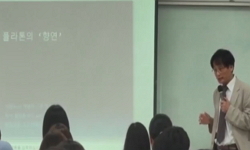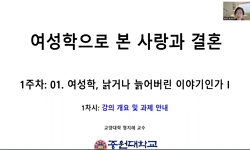This article explores the internal/external hierarchy of the oppressive structure and the possibility/impossibility of solidarity by analyzing the unique experience of oppression experienced by marriage immigrant women through intersectional recogniti...
http://chineseinput.net/에서 pinyin(병음)방식으로 중국어를 변환할 수 있습니다.
변환된 중국어를 복사하여 사용하시면 됩니다.
- 中文 을 입력하시려면 zhongwen을 입력하시고 space를누르시면됩니다.
- 北京 을 입력하시려면 beijing을 입력하시고 space를 누르시면 됩니다.
https://www.riss.kr/link?id=A106278099
-
저자
임지연 (건국대학교)
- 발행기관
- 학술지명
- 권호사항
-
발행연도
2019
-
작성언어
Korean
-
주제어
교차성 ; 『잘가라 ; 서커스』 ; 억압의 매트릭스 ; 국가의 아내 ; 돈 주고 사온 신부 ; 결혼 이주여성 ; 사랑 ; Goodbye ; Circus ; Matrix of Oppression ; Wife of State ; Bride Bought ; Married Immigrant Woman ; Love
-
등재정보
KCI등재
-
자료형태
학술저널
-
수록면
127-156(30쪽)
-
KCI 피인용횟수
0
- 제공처
-
0
상세조회 -
0
다운로드
부가정보
다국어 초록 (Multilingual Abstract)
The intersectional oppression of Hae-hwa, the main character of this novel, appears in following aspects; First, it appears as the control image such as the ‘Wife of State’ and the ‘Bride Bought.’ The process of discrimination and exclusion experienced by marriage immigrant women, who are ‘bought’ by the state and family system for care work and reproduction, is amplified through a path closely intertwined with state-family-woman-society-capital. Here, the body of marriage immigrant woman is re-hierarchized into settled woman and other women, sub-subjects and other sub-subjects, male immigrants and other immigrants. Second, the essence of the image of the 'Wife of State' or 'Bride Bought' lies in the sexuality of migrant women. Marriage migrant women's sexuality creates love with other men. Here, love becomes the arena of competition between oppression and desire. The male characters are violent and cynical and drive the main character to death by making a relationship of disrelation. On the other hand, the solidarity of the marriage migrant women paralyzes the matrix of oppression even for a while through empathy and criticism. The intersectional politics of marriage immigrant women in the post-national era criticize the duplexing and re-hierarchy within the category and suggest that the possibility/impossibility of love and solidarity to be carefully rearranged.
This article explores the internal/external hierarchy of the oppressive structure and the possibility/impossibility of solidarity by analyzing the unique experience of oppression experienced by marriage immigrant women through intersectional recognition. The concept of intersectionality reveals the matrix of oppression in which various oppressive mechanisms intensify and amplify one another rather than a single axis of oppression. It is a concept which reasons the problem of marginalized women in political sense for the fact that the oppressive mechanisms interact with each other and continue one after another to amplify the intensity of oppression, providing a basis for criticizing structures that makes vulnerable people more vulnerable.
The intersectional oppression of Hae-hwa, the main character of this novel, appears in following aspects; First, it appears as the control image such as the ‘Wife of State’ and the ‘Bride Bought.’ The process of discrimination and exclusion experienced by marriage immigrant women, who are ‘bought’ by the state and family system for care work and reproduction, is amplified through a path closely intertwined with state-family-woman-society-capital. Here, the body of marriage immigrant woman is re-hierarchized into settled woman and other women, sub-subjects and other sub-subjects, male immigrants and other immigrants. Second, the essence of the image of the 'Wife of State' or 'Bride Bought' lies in the sexuality of migrant women. Marriage migrant women's sexuality creates love with other men. Here, love becomes the arena of competition between oppression and desire. The male characters are violent and cynical and drive the main character to death by making a relationship of disrelation. On the other hand, the solidarity of the marriage migrant women paralyzes the matrix of oppression even for a while through empathy and criticism. The intersectional politics of marriage immigrant women in the post-national era criticize the duplexing and re-hierarchy within the category and suggest that the possibility/impossibility of love and solidarity to be carefully rearranged.
국문 초록 (Abstract)
이 소설에서 주인공 해화의 교차적 억압의 양상은 첫째, ‘국가의 아내’, ‘돈 주고 사온 신부’ 라는 통제 이미지로 나타난다. 국가와 가족제도가 돌봄노동과 재생산을 위해 돈을 주고 사온 결혼 이주여성이 경험하는 차별과 배제의 과정은 국가-가족-여성-사회-자본과 긴밀한 경로를 통해 맞물리며 증폭된다. 여기서 결혼 이주여성의 몸은 정주여성과 다른 여성, 하위주체와 다른 하위주체, 남성 이주자와 다른 이주자로 재위계화 된다. 둘째, ‘국가의 아내’나 ‘돈 주고 사온 신부’ 이미지의 핵심은 이주여성의 섹슈얼리티에 있다. 결혼 이주여성의 섹슈얼리티는 다른 남성들과의 사랑을 만든다. 여기서 사랑은 억압과 욕망의 각축장이 되는 장소다. 남성인물들은 폭력적이고 냉소적이며, 무관계적인 관계를 만듦으로써 주인공을 죽음으로 내몬다. 반면 같은 이주여성들의 연대는 공감력과 비판기능을 통해 억압의 매트릭스를 잠깐이나마 마비시킨다. 이처럼 탈국가 시대 결혼 이주여성의 교차적 정치성은 범주내부의 이중화와 재위계화를 비판하고, 사랑과 연대의 불/가능성을 세심하게 재배치할 것을 제안한다.
이 글은 천운영의 잘가라, 서커스를 중심으로 결혼 이주여성이 경험하는 고유한 억압의 경험을 교차성 인식을 통해 분석함으로써 억압구조의 내외부적 위계화와, 연대의 불/가능성을 ...
이 글은 천운영의 잘가라, 서커스를 중심으로 결혼 이주여성이 경험하는 고유한 억압의 경험을 교차성 인식을 통해 분석함으로써 억압구조의 내외부적 위계화와, 연대의 불/가능성을 탐색한다. 교차성 개념은 여성억압이 단일축이 아니라, 여러 억압기제들이 서로 강화하고 증폭하는 억압의 매트릭스를 드러낸다. 그것은 억압기제들이 상호작용하고, 연쇄적으로 이어지면서 억압의 강도를 증폭시키고, 취약한 정체성을 가진 이들을 더욱 취약하게 하는 구조를 비판할 수 있는 토대를 제공한다는 점에서 주변화된 여성의 문제를 정치적으로 사유할 수 있게 하는 개념이라고 할 수 있다.
이 소설에서 주인공 해화의 교차적 억압의 양상은 첫째, ‘국가의 아내’, ‘돈 주고 사온 신부’ 라는 통제 이미지로 나타난다. 국가와 가족제도가 돌봄노동과 재생산을 위해 돈을 주고 사온 결혼 이주여성이 경험하는 차별과 배제의 과정은 국가-가족-여성-사회-자본과 긴밀한 경로를 통해 맞물리며 증폭된다. 여기서 결혼 이주여성의 몸은 정주여성과 다른 여성, 하위주체와 다른 하위주체, 남성 이주자와 다른 이주자로 재위계화 된다. 둘째, ‘국가의 아내’나 ‘돈 주고 사온 신부’ 이미지의 핵심은 이주여성의 섹슈얼리티에 있다. 결혼 이주여성의 섹슈얼리티는 다른 남성들과의 사랑을 만든다. 여기서 사랑은 억압과 욕망의 각축장이 되는 장소다. 남성인물들은 폭력적이고 냉소적이며, 무관계적인 관계를 만듦으로써 주인공을 죽음으로 내몬다. 반면 같은 이주여성들의 연대는 공감력과 비판기능을 통해 억압의 매트릭스를 잠깐이나마 마비시킨다. 이처럼 탈국가 시대 결혼 이주여성의 교차적 정치성은 범주내부의 이중화와 재위계화를 비판하고, 사랑과 연대의 불/가능성을 세심하게 재배치할 것을 제안한다.
참고문헌 (Reference)
1 페트리샤 콜린스, "흑인페미니즘사상" 여이연 1-520, 2009
2 강진구, "한국소설에 나타난 결혼 이주여성의 재현 양상" 문화콘텐츠기술연구원 (11) : 171-191, 2011
3 이춘호, "한국 이주노동자의 위치인식에 따른 정체성 변화" 사단법인 아시아문화학술원 8 (8): 1093-1112, 2017
4 이미림, "표류하는 동아시아 여성의 타자적 삶" 한국문명학회 15 : 81-108, 2014
5 허윤, "포스트 세계문학과 여성-이주-장편서사의 윤리학: 황석영의 『바리데기』를 중심으로" 한국여성문학학회 (38) : 73-98, 2016
6 윤지영, "페미니즘 난국(feminism crisis)의 도발적 변곡점: 급진퀴어페미니즘은 가능한가?" 한국여성학회 33 (33): 141-198, 2017
7 권혜린, "탈국경 서사의 민족 번역 - 강영숙 『리나』를 중심으로" 한국문예창작학회 14 (14): 171-194, 2015
8 김재영, "코끼리" 실천문학사 1-358, 2005
9 소영현, "징후로서의 여성/혐오와 디아스포라 젠더의 기하학- 이주의 여성화, 이주노동의 가정주부화" 대중서사학회 23 (23): 85-117, 2017
10 김수미, "정체성, 권력, 교차성" 5 : 29-42, 2018
1 페트리샤 콜린스, "흑인페미니즘사상" 여이연 1-520, 2009
2 강진구, "한국소설에 나타난 결혼 이주여성의 재현 양상" 문화콘텐츠기술연구원 (11) : 171-191, 2011
3 이춘호, "한국 이주노동자의 위치인식에 따른 정체성 변화" 사단법인 아시아문화학술원 8 (8): 1093-1112, 2017
4 이미림, "표류하는 동아시아 여성의 타자적 삶" 한국문명학회 15 : 81-108, 2014
5 허윤, "포스트 세계문학과 여성-이주-장편서사의 윤리학: 황석영의 『바리데기』를 중심으로" 한국여성문학학회 (38) : 73-98, 2016
6 윤지영, "페미니즘 난국(feminism crisis)의 도발적 변곡점: 급진퀴어페미니즘은 가능한가?" 한국여성학회 33 (33): 141-198, 2017
7 권혜린, "탈국경 서사의 민족 번역 - 강영숙 『리나』를 중심으로" 한국문예창작학회 14 (14): 171-194, 2015
8 김재영, "코끼리" 실천문학사 1-358, 2005
9 소영현, "징후로서의 여성/혐오와 디아스포라 젠더의 기하학- 이주의 여성화, 이주노동의 가정주부화" 대중서사학회 23 (23): 85-117, 2017
10 김수미, "정체성, 권력, 교차성" 5 : 29-42, 2018
11 천운영, "잘가라, 서커스" 문학동네 1-290, 2005
12 게일 루빈, "일탈" 현실문화 1-904, 2015
13 이혜경, "이주의 여성화와 초국가적 가족:조선족 사례를 중심으로" 한국사회학회 40 (40): 258-298, 2006
14 연남경, "이주여성 재현의 서사학적 분석 - 『리나』, 『테러의 시』를 중심으로 -" 한국현대소설학회 (62) : 217-246, 2016
15 공선옥, "유랑가족" 실천문학사 1-267, 2005
16 수전 밀러, "우리의 의지에 반하여-남성, 여성 그리고 강간의 역사" 오월의 봄 1-696, 2018
17 한국이주여성인권센터, "아무도 몰랐던 이야기-폭력 피해 여성들의 생존 분투기" 오월의 봄 37-49, 2018
18 서성란, "쓰엉" 산지니 1-288, 2016
19 알랭 바디우, "사랑예찬" 길 1-165, 2010
20 김애란, "비행운" 문학과지성사 129-168, 2012
21 박찬순, "발해풍의 정원" 문학과지성사 1-383, 2009
22 황석영, "바리데기" 창비 1-301, 2007
23 강영숙, "리나" 랜덤하우스 1-382, 2006
24 이미림, "다문화경계인으로서의 코리안 디아스포라 연구-박찬순 소설을 중심으로-" 한중인문학회 (41) : 205-228, 2013
25 정현주, "다문화경계인으로서 이주여성들의 위치성에 대한 이론적 탐색: ‘경계지대,’ 억압의 ‘교차성,’ ‘변위’ 개념에 대한 검토 및 적용" 대한지리학회 50 (50): 289-303, 2015
26 래윈 코넬, "남성성/들" 이매진 1-448, 2013
27 최종렬, "국제결혼 이주여성에 대한 문화사회학적 접근 - 방법론적ㆍ윤리적 논의를 중심으로" 한국문화사회학회 4 (4): 147-205, 2008
28 한우리, "교차성×페미니즘" 여이연 1-187, 2018
29 임지연, "공감 개념의 확장과 다문화적 공감서사-<이슬람 정육점>을 중심으로" 한국문학치료학회 47 : 225-254, 2018
30 정현주, "경계를 가로지르는 결혼과 여성의 에이전시: 국제결혼이주연구에서 에이전시를 둘러싼 이론적 쟁점에 대한 비판적 고찰" 한국도시지리학회 12 (12): 109-121, 2009
31 에바 일루즈, "감정 자본주의" 돌베개 1-238, 2010
32 황정미, "‘이주의 여성화’ 현상과 한국 내 결혼이주에 대한 이론적 고찰" 한국여성연구소 9 (9): 1-37, 2009
33 Crenshaw, Kimberlé, "Mapping the margins: Intersectionality, identity politics, and violence against women of color" 43 : 1241-1299, 1991
34 Crenshaw, Kimberlé, "Demarginalizing the Intersection of Race and Sex: A Black Feminist Critique of Antidiscrimination Doctrine, Feminist Theory and Antiracist Politics" 1989 (1989): 139-167,
동일학술지(권/호) 다른 논문
-
구비설화 <삼정승 딸 만나 목숨 구한 총각>에 나타난 죽을 운명과 그 극복의 의미
- 겨레어문학회
- 김혜미
- 2019
- KCI등재
-
- 겨레어문학회
- 홍재범
- 2019
- KCI등재
-
- 겨레어문학회
- 김숙정
- 2019
- KCI등재
-
장애아동 재활치료사들의 ‘돌봄’의 의미 -설화 <아기장수> ‘다시쓰기’를 중심으로-
- 겨레어문학회
- 배진형
- 2019
- KCI등재
분석정보
인용정보 인용지수 설명보기
학술지 이력
| 연월일 | 이력구분 | 이력상세 | 등재구분 |
|---|---|---|---|
| 2028 | 평가예정 | 재인증평가 신청대상 (재인증) | |
| 2022-01-01 | 평가 | 등재학술지 유지 (재인증) |  |
| 2019-01-01 | 평가 | 등재학술지 유지 (계속평가) |  |
| 2016-01-01 | 평가 | 등재학술지 선정 (계속평가) |  |
| 2015-12-01 | 평가 | 등재후보로 하락 (기타) |  |
| 2014-01-09 | 학술지명변경 | 외국어명 : 미등록 -> Journal of Korean National Language and Literature |  |
| 2011-01-01 | 평가 | 등재학술지 선정 (등재후보2차) |  |
| 2010-01-01 | 평가 | 등재후보 1차 PASS (등재후보1차) |  |
| 2009-01-01 | 평가 | 등재후보 1차 FAIL (등재후보1차) |  |
| 2008-01-01 | 평가 | 등재후보학술지 유지 (등재후보1차) |  |
| 2006-01-01 | 평가 | 등재후보학술지 선정 (신규평가) |  |
학술지 인용정보
| 기준연도 | WOS-KCI 통합IF(2년) | KCIF(2년) | KCIF(3년) |
|---|---|---|---|
| 2016 | 0.44 | 0.44 | 0.49 |
| KCIF(4년) | KCIF(5년) | 중심성지수(3년) | 즉시성지수 |
| 0.44 | 0.48 | 1.059 | 0 |




 KCI
KCI KISS
KISS






